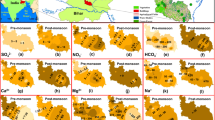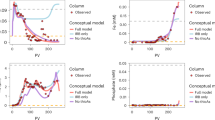Abstract
Bangladesh relies heavily on groundwater for the irrigation of dry-season rice. However, the groundwater used for irrigation often contains high concentrations of arsenic, potentially jeopardizing the future of rice production in the country. In seasonally flooded fields, topsoil arsenic concentrations decrease during the monsoon season, suggesting that flooding attenuates arsenic accumulation in the soils. Here we examine the chemistry of soil porewater and floodwater during the monsoon season in rice paddies in Munshiganj, Bangladesh, to assess whether flooding releases significant quantities of arsenic from the soils. We estimate that between 51 and 250 mg m−2 of soil arsenic is released into floodwater during the monsoon season. This corresponds to a loss of 13–62% of the arsenic added to soils through irrigation each year. The arsenic was distributed throughout the entire floodwater column by vertical mixing and was laterally removed when the floodwater receded. We conclude that monsoon floodwater removes a large amount of the arsenic added to paddy soils through irrigation, and suggest that non-flooded soils are particularly at risk of arsenic accumulation.
This is a preview of subscription content, access via your institution
Access options
Subscribe to this journal
Receive 12 print issues and online access
$259.00 per year
only $21.58 per issue
Buy this article
- Purchase on Springer Link
- Instant access to full article PDF
Prices may be subject to local taxes which are calculated during checkout





Similar content being viewed by others
References
Handbook of Agricultural Statistics (Ministry of Agriculture, 2007); available at <http://www.moa.gov.bd/statistics/statistics.htm>.
Field, D. I. Land Evaluation for Crop Diversification (Crop Diversification Programme, 1995).
Ali, M. A. et al. in Fate of Arsenic in the Environment (ed. Ahmed, M. F.) 7–20 (ITN International Training Network, 2003).
Abedin, M. J., Cotter-Howells, J. & Meharg, A. A. Arsenic uptake and accumulation in rice (Oryza sativa L.) irrigated with contaminated water. Plant Soil 240, 311–319 (2002).
Abedin, M. J., Cresser, M. S., Meharg, A. A., Feldmann, J. & Cotter-Howells, J. Arsenic accumulation and metabolism in rice (Oryza sativa L.). Environ. Sci. Technol. 36, 962–968 (2002).
Xu, X. Y., McGrath, S. P., Meharg, A. A. & Zhao, F. J. Growing rice aerobically markedly decreases arsenic accumulation. Environ. Sci. Technol. 42, 5574–5579 (2008).
Alam, M. B. & Sattar, M. A. Assessment of arsenic contamination in soils and waters in some areas of Bangladesh. Water Sci. Technol. 42, 185–193 (2000).
Meharg, A. A. & Rahman, M. M. Arsenic contamination of Bangladesh paddy field soils: Implications for rice contribution to arsenic consumption. Environ. Sci. Technol. 37, 229–234 (2003).
Norra, S. et al. Impact of irrigation with As rich groundwater on soil and crops: A geochemical case study in West Bengal Delta Plain, India. Appl. Geochem. 20, 1890–1906 (2005).
van Geen, A. et al. Impact of irrigating rice paddies with groundwater containing arsenic in Bangladesh. Sci. Total Environ. 367, 769–777 (2006).
Duxbury, J. M., Mayer, A. B., Lauren, J. G. & Hassan, N. Food chain aspects of arsenic contamination in Bangladesh: Effects on quality and productivity of rice. J. Environ. Sci. Health A A38, 61–69 (2003).
Hossain, M. B. et al. Spatial variability of arsenic concentration in soils and plants, and its relationship with iron, manganese and phosphorus. Environ. Pollut. 156, 739–744 (2008).
Panaullah, G. M. et al. Arsenic toxicity to rice (Oryza sativa L.) in Bangladesh. Plant Soil 317, 31–39 (2009).
Dittmar, J. et al. Spatial distribution and temporal variability of arsenic in irrigated rice fields in Bangladesh. 2. Paddy soil. Environ. Sci. Technol. 41, 5967–5972 (2007).
Roberts, L. C. et al. Spatial distribution and temporal variability of arsenic in irrigated rice fields in Bangladesh. 1. Irrigation water. Environ. Sci. Technol. 41, 5960–5966 (2007).
Ali, M. A. et al. in Fate of Arsenic in the Environment (ed. Ahmed, M. F.) 85–112 (ITN International Training Network, 2003).
Saha, G. C. & Ali, M. A. Dynamics of arsenic in agricultural soils irrigated with arsenic contaminated groundwater in Bangladesh. Sci. Total Environ. 379, 180–189 (2007).
Heikens, A., Panaullah, G. M. & Meharg, A. A. Arsenic behaviour from groundwater and soil to crops: Impacts on agriculture and food safety. Rev. Environ. Contam. Toxicol. 189, 43–87 (2007).
Islam, M. R. et al. Behaviour of Arsenic in Aquifers, Soils and Plants: Implications for Management, January 16–18, Dhaka<http://arsenic.tamu.edu/pub/pubpres/DHAKA/dhaka7.pdf> (2005).
Harvey, C. F. et al. Groundwater dynamics and arsenic contamination in Bangladesh. Chem. Geol. 228, 112–136 (2006).
Wenzel, W. W. et al. Arsenic fractionation in soils using an improved sequential extraction procedure. Anal. Chim. Acta 436, 309–323 (2001).
Roberts, L. C. et al. Arsenic removal with iron(II) and iron(III) in waters with high silicate and phosphate concentrations. Environ. Sci. Technol. 38, 307–315 (2004).
Burnol, A. et al. Decoupling of arsenic and iron release from ferrihydrite suspension under reducing conditions: A biogeochemical model. Geochem. Trans. 8, 12 (2007).
Burton, E. D., Bush, R. T., Sullivan, L. A., Johnston, S. G. & Hocking, R. K. Mobility of arsenic and selected metals during re-flooding of iron- and organic-rich acid-sulphate soil. Chem. Geol. 253, 64–73 (2008).
Coker, V. S. et al. XAS and XMCD evidence for species-dependent partitioning of arsenic during microbial reduction of ferrihydrite to magnetite. Environ. Sci. Technol. 40, 7745–7750 (2006).
Kocar, B. D., Herbel, M. J., Tufano, K. J. & Fendorf, S. Contrasting effects of dissimilatory iron(III) and arsenic(V) reduction on arsenic retention and transport. Environ. Sci. Technol. 40, 6715–6721 (2006).
Tufano, K. J. & Fendorf, S. Confounding impacts of iron reduction on arsenic retention. Environ. Sci. Technol. 42, 4777–4783 (2008).
Randall, S. R., Sherman, D. M. & Ragnarsdottir, K. V. Sorption of As(V) on green rust (Fe4(II)Fe2(III)(OH)12SO4·3H2O) and lepidocrocite (γ-FeOOH): Surface complexes from EXAFS spectroscopy. Geochim. Cosmochim. Acta 65, 1015–1023 (2001).
Su, C. & Wilkin, R. T. Arsenate and arsenite sorption on and arsenite oxidation by iron(II, III) hydroxycarbonate green rust. ACS Symp. Ser. 915, 25–40 (2006).
Bostick, B. C., Chen, C. & Fendorf, S. Arsenite retention mechanisms within estuarine sediments of Pescadero, CA. Environ. Sci. Technol. 38, 3299–3304 (2004).
Bostick, B. C. & Fendorf, S. Arsenite sorption on troilite (FeS) and pyrite (FeS2). Geochim. Cosmochim. Acta 67, 909–921 (2003).
Huerta-Diaz, M. A., Tessier, A. & Carignan, R. Geochemistry of trace metals associated with reduced sulfur in freshwater sediments. Appl. Geochem. 13, 213–233 (1998).
O’Day, P. A., Vlassopoulos, D., Root, R. & Rivera, N. The influence of sulfur and iron on dissolved arsenic concentrations in the shallow subsurface under changing redox conditions. Proc. Natl Acad. Sci. USA 101, 13703–13708 (2004).
Boudreau, B. P. The diffusive tortuosity of fine-grained unlithified sediments. Geochim. Cosmochim. Acta 60, 3139–3142 (1996).
Leaist, D. G. Mutual diffusion coefficients for binary aqueous solutions of arsenous, arsenic, and malonic acids. J. Chem. Eng. Data 52, 1319–1325 (2007).
Li, J. H. & Gregory, S. Diffusion of ions in sea water and in deep-sea sediments. Geochim. Cosmochim. Acta 88, 703–714 (1974).
Kirk, G. The Biogeochemistry of Submerged Soils (Wiley, 2004).
Simpson, I. C., Roger, P. A., Oficial, R. & Grant, I. F. Density and composition of aquatic oligochaete populations in different farmers’ ricefields. Biol. Fertility Soils 16, 34–40 (1993).
Grenz, C., Moutin, T., Picot, B. & Massé, H. Comparison between peepers and benthic chamber methods for the measurement of nutrient fluxes at the water–sediment interface. C. R. Acad. Sci. III 313, 239–244 (1991).
Urban, N. R., Dinkel, C. & Wehrli, B. Solute transfer across the sediment surface of a eutrophic lake: I. Porewater profiles from dialysis samplers. Aquat. Sci. 59, 1–25 (1997).
Hug, S. J. & Leupin, O. Iron-catalyzed oxidation of arsenic(III) by oxygen and by hydrogen peroxide: pH-dependent formation of oxidants in the Fenton reaction. Environ. Sci. Technol. 37, 2734–2742 (2003).
Buschmann, J., Canonica, S., Lindauer, U., Hug, S. J. & Sigg, L. Photoirradiation of dissolved humic acid induces arsenic(III) oxidation. Environ. Sci. Technol. 39, 9541–9546 (2005).
Brammer, H. The Geography of the Soils of Bangladesh (Univ. Press, 1996).
Databases and Statistics (Bangladesh Agricultural Research Council, 2008); available at <http://www.barc.gov.bd/Data_Stat.htm>.
Harvey, C. F. et al. Arsenic mobility and groundwater extraction in Bangladesh. Science 298, 1602–1606 (2002).
Acknowledgements
We thank T. Ruettimann, J. Traber, K. Barmettler and D. Gaertner for analytical support, T. Rosenberg, C. Farnsworth, S. Chowdhury, M. S. Alam and A. Rahman for help with field work, R. Neumann for help with procuring meteorological data and C. Dinkel for providing the field spectrometer. We are indebted to the people of Bashailbhog village and to M. F. Ahmed from the Bangladesh University of Engineering and Technology for their long-standing support of this project. Financial support of this research by the Swiss National Science Foundation (Grant 200021-15612/1 and 200020-113654/1) is gratefully acknowledged.
Author information
Authors and Affiliations
Contributions
L.C.R. planned and carried out the fieldwork and wrote the manuscript as part of her PhD thesis. L.C.R. and S.J.H. designed the sampling equipment and procedures. J.D., A.V. and R.K. carried out soil sampling and analyses. B.W. suggested the use of porewater samplers and O.A.C. provided support in modelling the floodwater data. G.C.S., M.A.A. and A.B.M.B. co-initiated the project and provided technical and logistic support during field work. A.V., S.J.H., R.K. and B.W. contributed to data interpretation and the writing of the manuscript. All authors contributed to the final version of the manuscript. This study was part of a larger research project initiated and supervised by S.J.H., A.V. and R.K.
Corresponding authors
Ethics declarations
Competing interests
The authors declare no competing financial interests.
Supplementary information
Supplementary Information
Supplementary Information (PDF 571 kb)
Rights and permissions
About this article
Cite this article
Roberts, L., Hug, S., Dittmar, J. et al. Arsenic release from paddy soils during monsoon flooding. Nature Geosci 3, 53–59 (2010). https://doi.org/10.1038/ngeo723
Received:
Accepted:
Published:
Issue Date:
DOI: https://doi.org/10.1038/ngeo723
This article is cited by
-
Geochemical variability in the soils of Bangladesh as affected by sources of irrigation water and inundation land types
SN Applied Sciences (2021)
-
A paddy field study of arsenic and cadmium pollution control by using iron-modified biochar and silica sol together
Environmental Science and Pollution Research (2019)
-
Salinization and arsenic contamination of surface water in southwest Bangladesh
Geochemical Transactions (2017)
-
Arsenic release metabolically limited to permanently water-saturated soil in Mekong Delta
Nature Geoscience (2016)
-
A Review of Groundwater Arsenic in the Bengal Basin, Bangladesh and India: from Source to Sink
Current Pollution Reports (2015)



